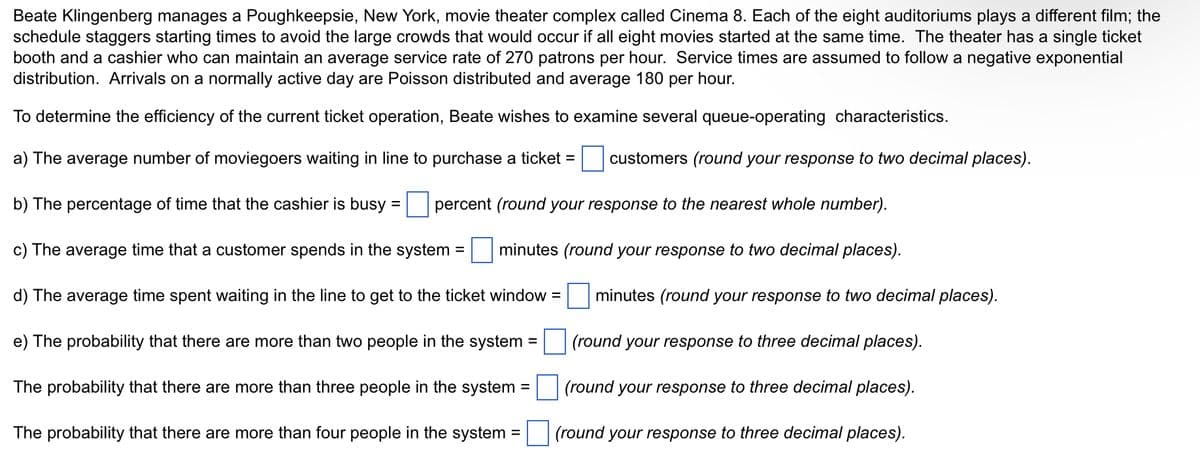Beate Klingenberg manages a Poughkeepsie, New York, movie theater complex called Cinema 8. Each of the eight auditoriums plays a different film; the schedule staggers starting times to avoid the large crowds that would occur if all eight movies started at the same time. The theater has a single ticket booth and a cashier who can maintain an average service rate of 270 patrons per hour. Service times are assumed to follow a negative exponential distribution. Arrivals on a normally active day are Poisson distributed and average 180 per hour. To determine the efficiency of the current ticket operation, Beate wishes to examine several queue-operating characteristics. a) The average number of moviegoers waiting in line to purchase a ticket = customers (round your response to two decimal places). b) The percentage of time that the cashier is busy = percent (round your response to the nearest whole number). c) The average time that a customer spends in the system = minutes (round your response to two decimal places). d) The average time spent waiting in the line to get to the ticket window= minutes (round your response to two decimal places). e) The probability that there are more than two people in the system = The probability that there are more than three people in the system = The probability that there are more than four people in the system = (round your response to three decimal places). (round your response to three decimal places). (round your response to three decimal places).
Beate Klingenberg manages a Poughkeepsie, New York, movie theater complex called Cinema 8. Each of the eight auditoriums plays a different film; the schedule staggers starting times to avoid the large crowds that would occur if all eight movies started at the same time. The theater has a single ticket booth and a cashier who can maintain an average service rate of 270 patrons per hour. Service times are assumed to follow a negative exponential distribution. Arrivals on a normally active day are Poisson distributed and average 180 per hour. To determine the efficiency of the current ticket operation, Beate wishes to examine several queue-operating characteristics. a) The average number of moviegoers waiting in line to purchase a ticket = customers (round your response to two decimal places). b) The percentage of time that the cashier is busy = percent (round your response to the nearest whole number). c) The average time that a customer spends in the system = minutes (round your response to two decimal places). d) The average time spent waiting in the line to get to the ticket window= minutes (round your response to two decimal places). e) The probability that there are more than two people in the system = The probability that there are more than three people in the system = The probability that there are more than four people in the system = (round your response to three decimal places). (round your response to three decimal places). (round your response to three decimal places).
Practical Management Science
6th Edition
ISBN:9781337406659
Author:WINSTON, Wayne L.
Publisher:WINSTON, Wayne L.
Chapter12: Queueing Models
Section12.5: Analytic Steady-state Queueing Models
Problem 12P
Related questions
Question

Transcribed Image Text:Beate Klingenberg manages a Poughkeepsie, New York, movie theater complex called Cinema 8. Each of the eight auditoriums plays a different film; the
schedule staggers starting times to avoid the large crowds that would occur if all eight movies started at the same time. The theater has a single ticket
booth and a cashier who can maintain an average service rate of 270 patrons per hour. Service times are assumed to follow a negative exponential
distribution. Arrivals on a normally active day are Poisson distributed and average 180 per hour.
To determine the efficiency of the current ticket operation, Beate wishes to examine several queue-operating characteristics.
a) The average number of moviegoers waiting in line to purchase a ticket =
customers (round your response to two decimal places).
b) The percentage of time that the cashier is busy:
percent (round your response to the nearest whole number).
c) The average time that a customer spends in the system = minutes (round your response to two decimal places).
d) The average time spent waiting in the line to get to the ticket window =
e) The probability that there are more than two people in the system =
The probability that there are more than three people in the system
The probability that there are more than four people in the system =
=
=
minutes (round your response to two decimal places).
(round your response to three decimal places).
(round your response to three decimal places).
(round your response to three decimal places).
Expert Solution
This question has been solved!
Explore an expertly crafted, step-by-step solution for a thorough understanding of key concepts.
Step by step
Solved in 3 steps with 6 images

Recommended textbooks for you

Practical Management Science
Operations Management
ISBN:
9781337406659
Author:
WINSTON, Wayne L.
Publisher:
Cengage,

Practical Management Science
Operations Management
ISBN:
9781337406659
Author:
WINSTON, Wayne L.
Publisher:
Cengage,